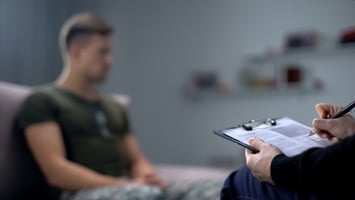Report Finds VA’s Prescribing of Benzodiazepines to Homeless ‘Risky,’ ‘Inappropriate’

Homeless veterans with mental illness who use Veterans Affairs (VA) health services are less likely to receive prescriptions for benzodiazepines than those with mental illness who are not homeless, according to a report published this week in Psychiatric Services. When homeless veterans are prescribed benzodiazepines, however, they appear more likely than their peers to receive prescriptions that put them at risk for substance use disorder, overdose, and death, the study found.
Drug overdose is a leading cause of death among homeless people, and benzodiazepines are often implicated in such overdose deaths, wrote Katherine Koh, M.D., M.Sc., of Massachusetts General Hospital–Harvard Medical School and colleagues.
“Asking patients about whether and how they combine substances and counseling them about these risks should be part of clinical conversations about benzodiazepine prescribing,” Koh and colleagues wrote.
The researchers examined 2018-2019 national data from the VA, specifically focusing on benzodiazepine prescribing among 244,113 homeless veterans with mental illness and 2,763,513 veterans with mental illness who were not homeless. All veterans included in the study had a primary or secondary diagnosis of a mental illness, as determined by ICD-10 codes. Veterans were categorized as being homeless if they had used any VA homelessness program.
The benzodiazepines most frequently prescribed to veterans included lorazepam, clonazepam, alprazolam, and diazepam. The researchers found that 9.4% of veterans who were not homeless were prescribed benzodiazepines at the VA compared with 7.5% of veterans who were homeless—a difference that the authors noted was statistically significant. Other findings included the following:
- Homeless veterans who sought VA care also had a higher rate of concurrent benzodiazepine prescriptions than those who were not homeless (9.4% vs. 7.0%).
- Homeless veterans who sought VA care had a higher rate of concurrent prescriptions for benzodiazepines and opioids than those who were not homeless (36.9% vs. 31.2%), especially oxycodone (12.4% vs. 9.7%) and hydrocodone (13.9% vs. 12.3%) or sedatives (61.9% vs. 45.9%).
- Of those with a benzodiazepine prescription, alcohol use disorder was more prevalent in the group who was homeless relative to the group who was not homeless (24.2% vs. 5.4%), as was drug use disorder (24.3% vs. 3.8%). (Drug use disorder was defined as a substance use disorder other than alcohol use disorder.)
“Structured approaches to the benzodiazepine conversation … may be useful for providers who find themselves in the dilemma of not wanting to prescribe benzodiazepines because of safety issues while striving to maintain a therapeutic alliance,” the authors wrote. This conversation should include nonpharmacologic strategies and interventions to treat conditions, such as anxiety or insomnia.
For related information, see the Psychiatric News article “M.D.s Call for Community Resources Amid Plans to Force Homeless Into Care.”
(Image: iStock/FatCamera)
Don't miss out! To learn about newly posted articles in Psychiatric News, please sign up here.






